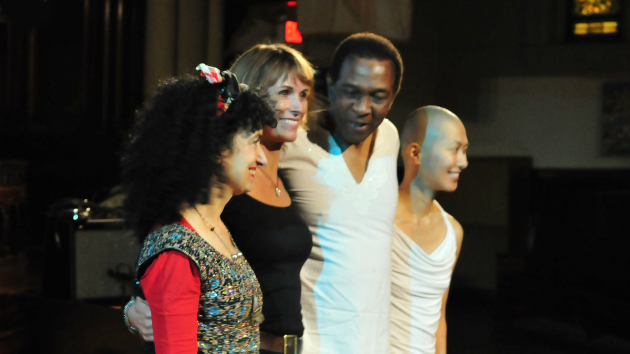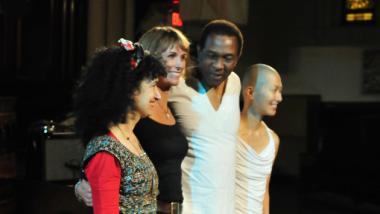
In his 2011 autobiography, Crossover, composer Carman Moore declares his personal motto: “Don’t try to predict me. You’ll just be wasting your time.” Unpredictability for the 78-year-old Moore dates back at least as far as his studies in 1950s New York City with jazz pianist and composer Hall Overton and in a masters program at Juilliard. While launching his compositional career, Moore also covered new music, jazz, and pop for the Village Voice. He co-founded The Society of Black Composers, taught at Yale and other campuses, and founded the Skymusic Ensemble to showcase his own, jazz-infused creations. Currently a Guggenheim Fellow, Moore is bringing to Berkeley’s Black Repertory Theater on March 31 his song cycle, Girl of Diamond Mountain, billed as “a story of child sexual abuse and about becoming whole again” and developed with a MacDowell Fellowship.
Tell us about how this topic took musical form.
My friend Lotte Arnsbjerg visits me every now and then, and at some point, three or four years ago, we started improvising songs. I would sit at the synthesizer and start up in one sound or another, and she would just take it and run with it. We recorded as many as 50 songs, and a certain number of them had the feel of this problem of child abuse. She told me that she herself was a survivor. So we started structuring this evening of some 14 songs.
Did the topic of sexual abuse seem fitted to vocal music?
Yes. It starts with her as a grownup, thinking back in a grownup voice. Then she goes into a childlike voice, singing a lot about Nature, which is the only thing the abused child can count on for a sense of reality. There are two songs which, in different ways, are about the abuse, and the next piece, which is long and becomes operatic, chronicles the thing as it happens and closes with an aria. The next section is what happens from the abuse; she’s a young woman who doesn’t think much of herself. But as the songs go on, she matures, and her last song, “Toward the Light,” has the feeling of coming out of this dark place. The “Diamond Mountain” refers to her tears falling: They become diamonds.
What are the other elements in the production?
I’ll be onstage [playing synthesizer]. Our dancer, Kiori Kawai, represents the girl at several stages. And there are projections by Caterina Bertolotto, paintings and touched-up photographs, which behave like a film background. I have not heard anyone do anything quite like this. The things that came from my head through my fingers were just inspired by the dramatic moment. I have not heard anyone do anything quite like this. The things that came from my head through my fingers were just inspired by the dramatic moment.
Is there an apparent influence of your Juilliard training?
It’s more classical than anything, but there’s a jazz piece in it, where she’s knocking herself around, saying, “I’ll do anything for you, as long as I can kill my spirit”, and I use the bass and a few piano notes. But it’s actually more tonal than if I’d sat down to write a “classical” piece.
You came up in New York while twelve-tone was still holding sway.
I certainly learned to write twelve-tone music, but the point was the sound and the freshness of the tones — that’s what Hall Overton was talking about. He said, “Learn as much as you can, fill up your left brain, then go intuitive.” Then I studied with Luciano Berio [at Juilliard]. He’d been a twelve-tone composer, but had gone past it and become one of the great intuitive composers of the 20th century.
What motivated your formation of The Society of Black Composers in 1968?
Within the white establishment of composition, it felt like we were either being ignored or not honored. But more importantly, it was about us finding out what it meant to be a black composer. Jazz was being honored — it was the time of Duke Ellington, Miles Davis, and Thelonious Monk — but as a result, the general public didn’t think there were any black classical composers. We put the group together to naysay that.
I know [black bassist and composer] Charles Mingus had pushed for recognition in the concert hall, beyond jazz clubs and festivals and recordings.
And luckily, I came along after that, and was commissioned by Seiji Ozawa to do this piece called Gospel Fuse, for symphony orchestra and gospel quartet (one of whom was Cissy Houston, Whitney’s mother). And the crazy part was, that premiere, with the San Francisco Symphony [January 22, 1975], was one night before the New York Philharmonic premiere of my Wildfires and Field Songs. So I got on the red-eye and went slipping back to New York. It was nuts! Of course, when you’re young you think, maybe this is the way it is!
Have any racial problems persisted for black classical composers?
I don’t think so. The problem is having a career as an American classical composer, we’re all in the same pool. Which is why it was so meaningful that I was commissioned by the American Composers Orchestra to do MADIBA, about Nelson Mandela, which premiered last month at Carnegie Hall. It’s almost a cello concerto; I was thinking about the sound of his speaking voice.
How was it received?
Tumultuously!
And you’ve already performed Girl of Diamond Mountain in New York and Denmark.
We get standing ovations, from those people who make it to the end. Others get so moved, they have to move themselves outside for a walk, But that’s our job, to bring up things, and because the music is strong and authentic, it acts sort of as a nurse. I had forgotten that right here, in my own head and hands, are the media for moving people. And some of those people who are survivors of sexual abuse have come up and just want to talk. So at the end of our performances, we have a discussion period, with some professionals in the field onstage. I had forgotten that right here, in my own head and hands, are the media for moving people.
Has your experience as a music journalist and critic informed your music?
Very much! I have been blessed with the ability, though it’s learned, of being conscious and unconscious at the same time.
So you have a little critic sitting on your shoulder.
Yes, always. But the critic will not have anything to say unless something starts getting dangerous.

